Today, most of the furniture items placed in the living room, nursery, kitchen and bathroom have retractable elements that are structurally drawers, countertop extensions, trays and transformable additions. Currently, when installing them, various categories of guides are used, which significantly increase the ergonomics and ease of use of furniture.
Despite the fairly widespread sled guides in the form of plastic or wooden bars, today roller and ball guides are becoming more common.
Despite the simplicity of design, low cost and ease of installation, ball devices are considered their worthy alternative. Despite the high price and the laid design, this type of fittings has the following advantages:
- greater smoothness and quiet operation;
- more uniform load distribution over individual rolling elements (balls);
- higher stability, which minimizes the distortion of the box;
- greater reliability - even with a defect in several balls, the load is evenly redistributed to the rest.
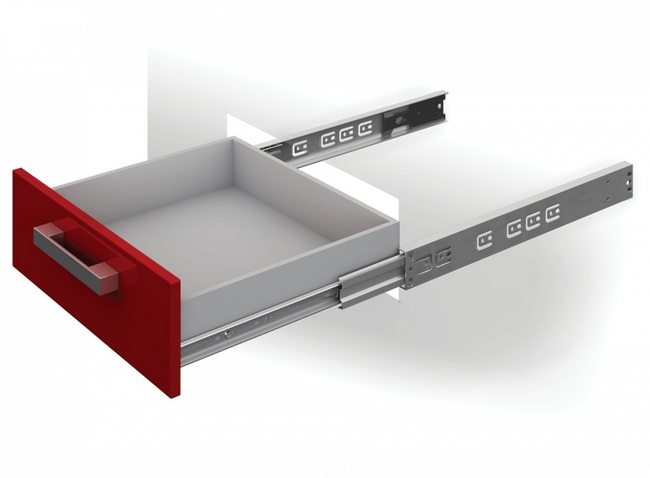
Features of ball systems
Today, the industry produces two-row and four-row ball guides of full (extra-long) extension. Despite the identity of the designs, the installation and operation of two-row devices is somewhat different from four-row ones. In addition, the cost of the first category is much lower, and they are designed for a load not exceeding 35.0 kilograms. Despite the high prevalence of the first category of products, four-row systems have a longer uptime and are able to withstand higher specific loads.
The design of this category furniture fittings represents two metal profiles in contact with each other by means of ball rolling elements. Balls made of steel or nylon are evenly distributed in the recesses of the cradles.
The length of the profile (lodgment) or its multi-section design allows you to push the drawer to its full depth, so that back wall available for review. To prevent extraction by an unacceptably large amount, this type of device is often additionally equipped with closers or safety locks (stops), which greatly increase the convenience of using retractable computer desk tops.
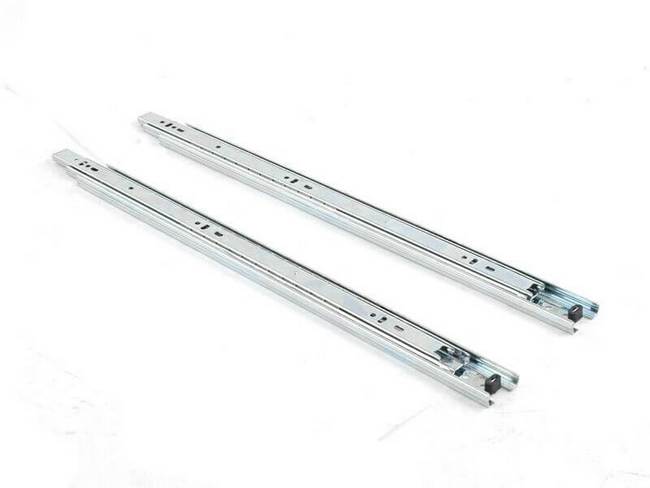
Pros and cons of designs
In addition to the advantages described above, which are characteristic of both two-row and four-row systems, extra-long extension ball fittings have the following advantages:
- A wide range of extension values, which depends on the specific product size and starts from 150.0 millimeters.
- A variety of colors of non-ferrous metallization, up to antique bronze or gold;
- The presence of a closer makes the operation of these devices absolutely safe.
- Full extension systems, unlike other types of ball guides, provide a complete inspection of the interior of the drawer without dismantling the lodgements.
- Can be used in special-purpose furniture - workbenches, drawer racks, in various designs of dishwashers, refrigerators and ovens.
- A wide range of full extension rails equipped with additional devices - clamps, facade regulators and other rather useful and ergonomic technical trifles.

Of course, like any design, certain, sometimes quite specific, disadvantages are inherent in this type of furniture fittings. The main disadvantages (in addition to the high cost) of full extension devices can be considered:
- the impossibility of fixing the extended element in the intermediate position in standard designs;
- exactingness to operational care;
- the difficulty of matching the color of furniture - most of the guides are not painted, but anodized;
- more complex and time-consuming installation, requiring precise marking and careful installation.

Application features
In addition to ordinary household furniture products, ball guides have found the widest application in furniture for specific purposes. For example, the cramped space of the bathroom does not allow the use of cabinets with drawers of standard length, so fittings that make it possible to fully extend shallow drawers are suitable here. Due to the quietness of operation, full extension systems are equipped with cabinets in medical institutions, drawer racks for archives, recording studios, where maintaining silence is one of the working conditions. To increase the noiselessness of their operation, some manufacturers additionally enclose metal balls in plastic separators.

On a note!
Special guides with a square section often have the possibility of a hidden installation (in a groove) that makes the fittings completely invisible from the outside. It has found wide application in expensive furniture, the cost of which is not particularly affected by the high price of ball guides.
Many homemade "homemade" products, when making, often use full extension ball fittings for shelving for a small TV or even for a fairly heavy microwave oven.
Of course, the prevalence of ball guides is significantly influenced by their cost. Today in the furniture fittings market there are various devices of full extension of Russian and Chinese production.
- A Russian set capable of withstanding 45.0 ... 50.0 kilograms (the weight of a microwave oven), having an extension depth of 400.0 ... 450.0 millimeters, will cost the buyer at least 200.0 rubles.
- Chinese full extension guides with a depth of up to 400.0 millimeters are offered at a price equivalent to 1.0 ... 2.0 US dollars.
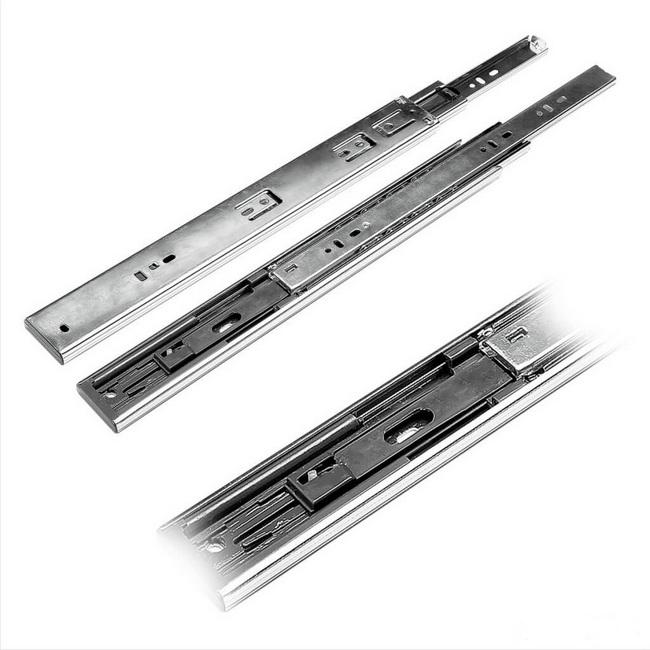
Metallization of lodgements is not caused by the whim of manufacturers, but by operational requirements. For normal, long-term operation of the balls, their periodic lubrication is required. Painted surfaces in contact with mineral lubricants will quickly fail.
Today, furniture fittings with the following types of anodized coating are on sale:
- silver or black zinc;
- various shades of bronze;
- polished stainless steel "chrome-plated";
- blackening (oxidation).
In conclusion, I would like to note that the furniture fittings market is quite dynamic and constantly updated. Today you can find ball guides that do not require lubrication and high-precision (precision) systems. So far, they have not been widely used in furniture products, but over time, with increasing requirements for comfort and lower prices, they will undoubtedly find their niche in household products.
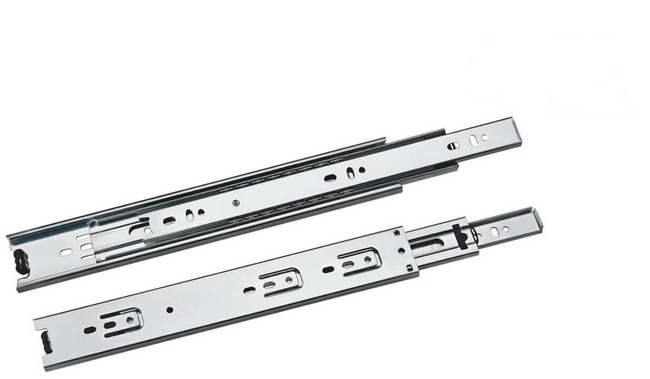
Video
The review provides detailed instructions on how to properly mount the rails on the cabinet.
And boxes. A sliding wardrobe, a kitchen set or a dressing room, the undeniable advantages of using drawers and drawers over conventional shelves have led to the fact that it is now difficult to imagine a place in the house where they would not be used.
Ease of Access- retractable mesh baskets and drawers make it easy to get things that are in the depths. For example, in the kitchen, in order to get a frying pan that is deep in the headset, you just need to pull out the drawer and get it. In the case of ordinary shelves, you would first have to take out all the dishes on the shelf in order to free access to the necessary frying pan, and then put all the items taken out at the beginning back. Retractable mesh baskets and drawers provide direct access to your belongings.
Use of the entire useful space of the cabinet - providing convenient and easy access to contents, pull-out baskets allow rational use of the entire internal space of baskets and drawers, which is especially important for small sliding wardrobes. Retractable mesh baskets and drawers keep your home organized.
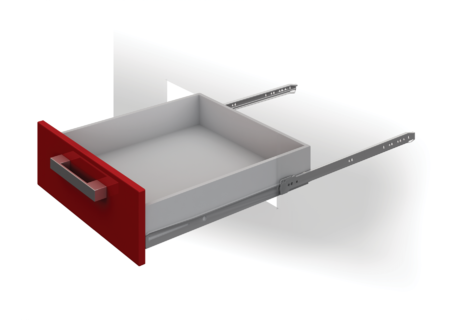
However, it is not possible to assemble a pull-out mesh basket or drawer without a pull-out rail. There are a huge number of varieties and modifications of retractable guides that differ in design, size, extension size, method of attachment to the retractable furniture element, in their bearing capacity, and so on ... Currently, two types are most common: roller guide and ball guide.
Roller guides.
Easy installation, easy extension and low price - these are the three main components of the popularity of roller guides. However, this type of guide has a number of disadvantages: drawer does not extend to the end, when opening the guides make a lot of noise, withstand only a small load.
Roller guides consist of two parts, one of which is rigidly mounted on the sliding element, and the other on the cabinet frame. The extension occurs due to plastic rollers interspersed in special grooves. You can remove the drawer with roller guides by pulling it out as far as possible, lifting it up a little, and then pulling it even further. There are no buttons or hidden mechanisms needed to remove the drawer. The box is installed in the reverse order.
Ball guides.
Ball guides belong to the extension system of a higher class than roller guides. Among the indisputable advantages of ball guides are full extension and drawers, the ability to withstand a significant load, almost twice that allowed for roller systems, noiselessness and smoothness of extension, high reliability and long service life. The disadvantages of this type of guides include only a higher cost.
Full extension ball guides are more complex to manufacture and consist of three movable elements. They are delivered already assembled, for installation it is necessary to disassemble the guide by unfastening the half fixed on the sliding element (using a special latch),
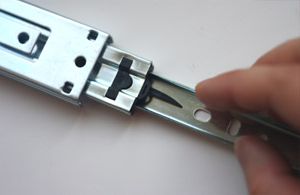
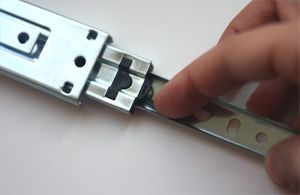
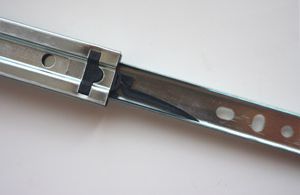
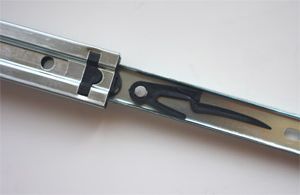
after installation in the product, both halves of the guide must be aligned with each other and push the drawer until a click is heard. The extension occurs due to several rows of balls held in cages, interspersed in special grooves.
On the surface of the difference between ball and roller guides, they essentially do the same thing; allow you to open and close the drawer. However, the difference between them is obvious, roller guides are usually used in the "budget" furniture ranges, due to their low cost. Ball guides, due to a more complex design and production technology, cannot compete with roller guides in terms of price, but due to their higher consumer qualities, they are widely in demand among consumers who value quality, comfort and reliability.
More recently, all retractable furniture boxes slid in grooves along wooden or plastic guides. This design was very simple, but very impractical - in the process of wear, chips and dust formed, the drawers were pulled out with difficulty and creaking, often torn off the guides ... Well, there was no question of automatic closing with a slight push (or even on springs) !
However, progress does not stand still, and the outdated design was replaced by new ones - ball / roller guides. All of the above shortcomings have been eliminated: the very principle of the “bearing” design ensures easy and smooth sliding, noiselessness, and the complete absence of chips or other contaminants. Modern guides practically do not wear out (which means that the ease and noiselessness of sliding is preserved over time) and do not require adjustment during operation. But, as with other types of fittings, for the optimal choice of the desired guides, it is advisable to understand their design ...
How does it work?
In general, the design of furniture rails is quite simple. This is a pair of stamped metal plates with narrow, perpendicular grooves. The plates are connected to each other precisely through these grooves, where the working cage with balls is installed (or along which the rollers slide - in the case of a detachable design). Thanks to this, the plates can slide freely relative to each other. There are holes on the body of the plates - through them one of them is attached to the sidewall of the box, and the other to the furniture body. It turns out a ready-made movable system (of course, to fix a drawer or a sliding shelf, the guides must be installed on both sides).

Where are the rollers?
Depending on the type of furniture, the guides used can have one of two basic types of construction. The first is roller guides. They are arranged extremely simply: a metal bar with a roller at the end and a flat groove bent towards the roller. The other plate has a similar structure (in principle, it can have a strictly mirror design, but in practice the plates are still somewhat different). Now, if you connect these plates together, then the first roller will slide along the second groove, and the second roller, on the contrary, will slide along the first groove. When pulling out the drawer, the rollers approach each other, and when closed, they are as far apart as possible.
The advantage of such a system is its extreme simplicity, and hence reliability. A minimum of moving elements (only a pair of rollers) provides a high resource. And most importantly, roller guides are collapsible. If you pull the drawer out to the limit and slightly raise its rear edge, the roller will come out of the reciprocal groove and the guide plates will disperse - it will be just as easy to assemble them back.
Where are the balls in the "telescope" from?
Another type of rail design is non-separable, called "telescopic". In it, the working plates are inserted one into the other, and their end planes are concave grooves. Balls connected in a cage slide along these grooves - it is she who connects the plates to each other (it's the same as the outer and inner rings of a ball bearing). It turns out a non-separable design in which the inner plate has the ability to extend from one side of the outer one - like a telescope lens (hence the name).
Otherwise, the principle of operation is similar to roller guides: one plate is attached to the furniture body, the other to the side of the drawer (or shelf) - we get a retractable structure. Telescopic rails are often used for heavy boxes that need to be secured against accidental falling out when open. They also install "telescopes" on retractable shelves under the keyboards, obviously for the same purpose - to insure valuable equipment from accidental falling when the shelf is carelessly opened to the limit.
Due to the non-separable design, ball telescopic guides are well insured against distortions - this is their advantage over roller guides. The probability of contamination or ingress of foreign particles into a closed ball cage is also significantly lower, which means that “telescopes” are more reliable during long-term operation. However, their main drawback compared to rollers is their non-separable design. In some cases, this is a fundamental selection criterion.

Who is more reliable?
In general, both types of guides (both ball and roller) can differ significantly in shape and size (length, width, reach in a fully open state, number and location of attachment points, etc.). This allows you to use the desired type of fittings in specific furniture designs.
But the bearing capacity of the guides is determined not so much by the design as by the thickness of the metal of the plates. It is noted that reliable guides must have a metal thickness of at least 1 mm (preferably 1.2 mm).
The quality difference is:
- high tolerance for straightness of the plates (“curved” plates lead to rapid wear of the rollers);
- complete coverage of the rollers by the working plane of one of the guides (while the other only supports them, compensating for small manufacturing inaccuracies);
- the presence of protrusions on the slats for fixing from falling out in the extreme position;
- the possibility of self-closing fittings under its own weight of the box;
- easy, without side play rotation of the rollers;
- with the exception of touching the mounting screws of the rails with rollers.
Qualitative have characteristic features:
- branding - for the manufacture of such a "jewelry" design, a solid production base and the reputation of the manufacturer are very important!
- high quality metal (and sufficient thickness - see above);
- reliability of fasteners (here it is more important than for roller guides);
- easy, silent sliding;
- no need to mill a groove for installation (which is often required for "budget" ball guides);
- easily collapsible design - which simplifies both installation and operation (it is possible to remove the box, as is the case with initially collapsible roller guides);
- relatively small bar height with a significant load capacity;
- the presence of a closer for automatic closing.
As you can see, the concept of "quality" for ball guides basically comes down to the presence of additional "bells and whistles". This is natural, since "telescopes" are inherently more reliable than roller guides. And when choosing a good manufacturer (as well as avoiding buying a fake), there should be no problems with the reliability, resource and functionality of ball guides.
And what to choose?
A sensible buyer may ask a reasonable question: why do we need ball guides at all? After all, they are significantly (sometimes 3 times!) More expensive than roller ones. Yes, even non-separable ... What are their advantages, if any?
Below is a summary of the key characteristics of both types of rails.
Roller:
- advantages - low price, easy installation, low pull-out effort;
- disadvantages - departure limitation (the drawer always does not extend to the end), a lot of noise during operation, low "load capacity" (carrying capacity of the guides).
Ball:
- advantages - significant load capacity (almost twice as large as that of roller ones), extension of the plates to the full length, smooth and silent operation, highest reliability and long period of operation;
- disadvantages - complicated installation (preliminary disassembly of the structure assembled at the factory is required, which is fraught with damage to the guide), higher cost.
In principle, it is somewhat incorrect to compare "on the forehead" ball and roller guides. The first is an elite class of fittings, the niche of which is also located in the sector of expensive, designer furniture models. The second type of guides is a "budget" solution used everywhere. However, do not think that their low price is a guarantee of poor quality. On the contrary, roller guides are very convenient and quite reliable. But if you want "something more" for your furniture - then the choice of "ball telescope" is inevitable!
Publication date: 19.08.2016
The materials were prepared by the specialists of the Trayv-Komplekt company.
Full or partial copying of the content is possible only after agreement with the site administration by e-mail.
As you know, one of the main types of furniture fittings are retractable systems or guides. They are widely used in kitchens , wardrobes , chests of drawers, bedside tables and other furniture.
The main types of guides:
Sidewalls with roller guides or metaboxes;
Ball or telescopic guides;
Concealed ball guides;
In addition, according to the method of extension, all guides are divided into partial and full extension systems. In the first case, the drawer extends to a limited distance, and in the second case, the drawer extends to the entire length of the guides, which is undoubtedly much more convenient. Accordingly, full extension systems have a more complex design and are more expensive. To make the right choice, consider the advantages and disadvantages of these drawer systems.

Roller guides- This is the most inexpensive type of retractable systems. The drawer is pulled out using rollers. The supporting part is attached to the sidewall of the furniture, and the second part of the rails is attached with screws to the bottom of the box. Roller guides of full and partial extension differ in price by about 4-5 times. To choose the right quality roller guides, you need to pay attention to the thickness of the metal. It should be noted that when installing boxes longer than 50 cm, it is better not to use this type of guide. This fitting is practically not suitable for bulky drawers. The bearing capacity of these guides is up to 10 kg. They are quite noisy in operation and do not differ in durability.
Sidewalls with roller guides or metaboxes (metalboxes) is a system with metal sidewalls on roller guides. The sidewall of the box here is the supporting part of the metabox. The roller system of metaboxes is much more reliable than the previous one, the rollers are made of extra strong plastic. The thickness of high-quality guides should be at least 1.0 mm. The bearing capacity of metaboxes is up to 20 kg. As an improved version of roller guides, metaboxes are successfully used in the manufacture of inexpensive furniture for kitchens and offices.
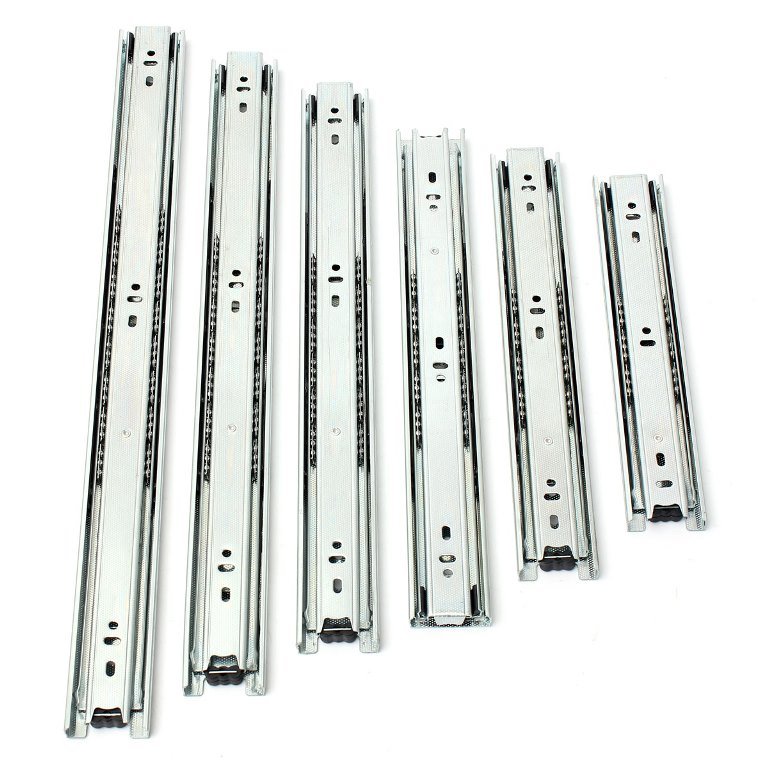
Ball guides (telescopic)- This is the most reliable type of mid-range drawer systems. The extension of the drawer in this case is carried out using steel ball bearings. They are virtually silent in operation and able to withstand a much greater load than the most powerful roller systems. The bearing capacity of these guides is up to 40-60 kg. In cases where boxes are made for storing heavy objects, only ball guides should be used. Although ball guides are about 2-3 times more expensive than roller guides, they are reliable, have an aesthetic appearance and are easier to install.
Concealed ball guides is a modern take on ball guides in furniture. They are attached to the bottom of the box, so they are not visible. For comfortable and silent closing, shock absorbers - closers were developed. The built-in closer mechanism has a spring mechanism and oil dampers, which allow you to close the drawer smoothly and silently.
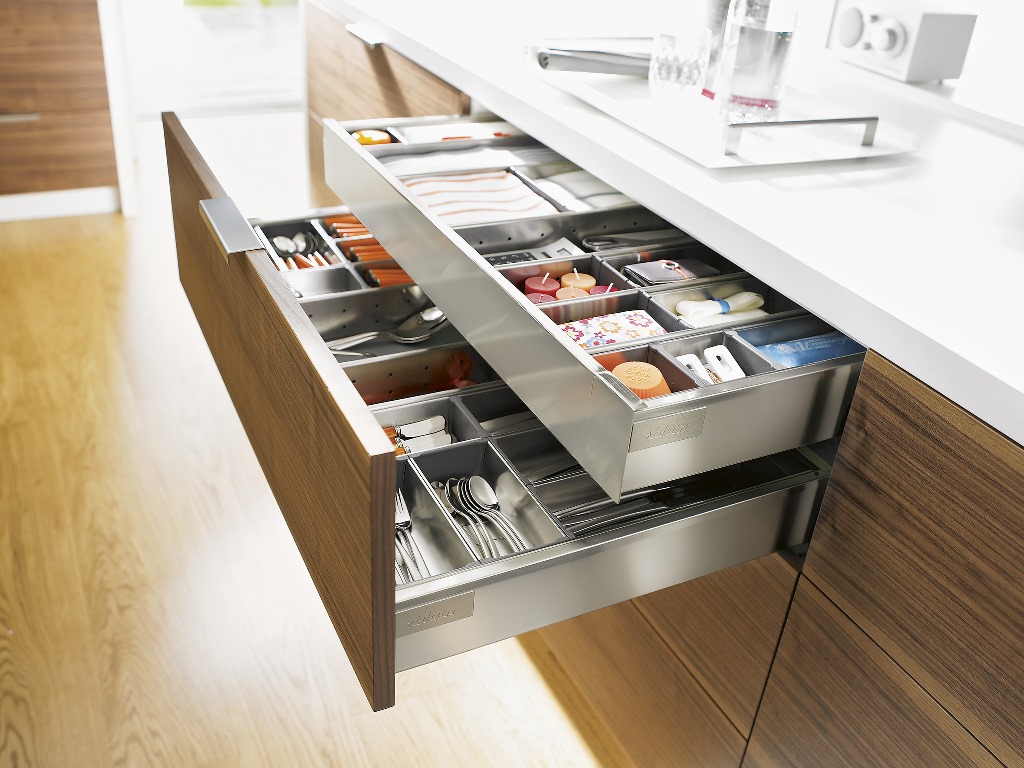
Tandemboxes- this is a full extension system in which the bottom and back wall are made of laminated chipboard, and the metal or glass sidewalls have a tubular railing. It is a high-quality and modern concealed drawer system with automatic closing, thanks to which even heavily loaded tall drawers slide like weightless. The bearing capacity of tandemboxes reaches 50 kg. The cost of tandemboxes is noticeably higher than metaboxes, but they can withstand a weight that is 2-3 times higher than the capabilities of metaboxes. And if they are equipped with an electric drive with sensors for touch or movement, you just need to touch the front of the drawer without making any effort, and it will open silently and smoothly.
In all the variety of furniture fittings, choosing the best option for guides is not so difficult. If you need an economical option for furniture with small drawers, you can opt for roller guides. And if you want to protect yourself and your loved ones from frequent breakdowns and endless furniture repairs, choose ball guides of any kind and design. If you want to equip your furniture with the latest technology, choose tandem boxes equipped with additional features.
